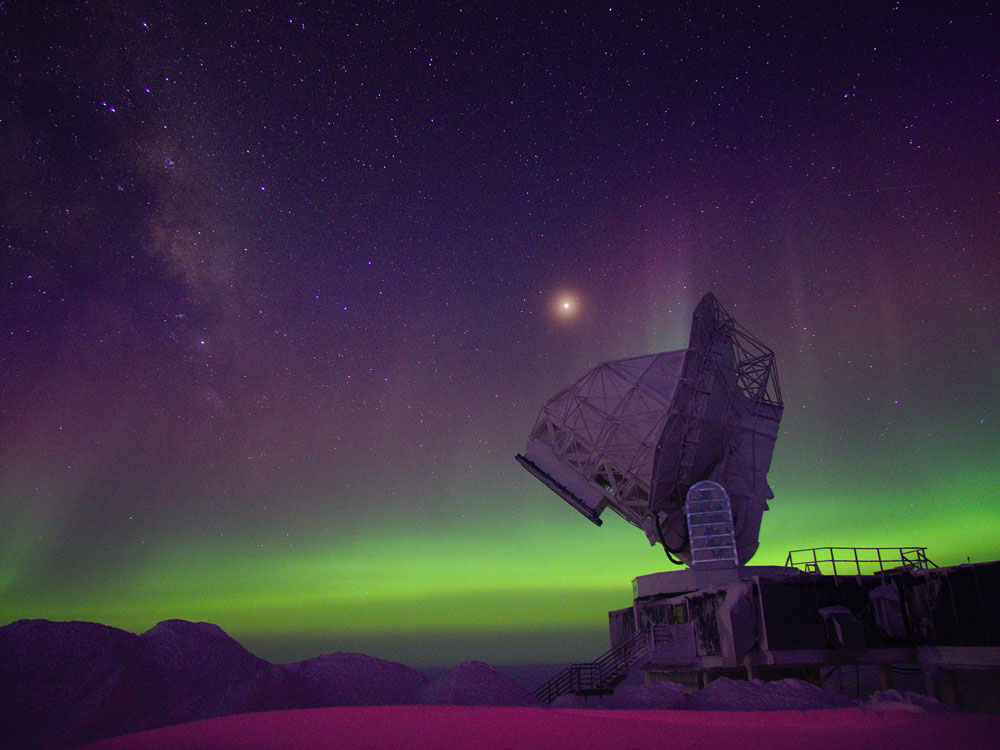
In November 2018, Joshua Montgomery returned from his most recent trip to the highest, coldest and driest continent on earth: Antarctica. From January 9 to November 17, 2018, the PhD candidate in Physics lived and worked with 40 other technicians and scientists at the Amundsen–Scott South Pole Station, maintaining and operating the South Pole Telescope (SPT) that allows astrophysicists to study the celestial dome and Cosmic Microwave Background radiation, the light left over from the Big Bang. The SPT is the biggest physical dish (10 meters) for astrophysics at the South Pole.

It was Montgomery’s third, and longest, stay at the bottom of the earth. “The saying goes: the first time you go [to Antarctica] for the experience,” says Montgomery with a laugh. “The second time you go for the money. The third time you go because you don’t belong anywhere else.”
Montgomery’s tasks included doing daily checks and maintenance on the SPT, greasing and checking the components, and monitoring the quality of the data. The SPT collaboration is made up of over a dozen (mostly North American) institutions, including McGill; the University of Chicago; the University of California, Berkeley; Harvard/Smithsonian Astrophysical Observatory; the University of Colorado Boulder; and the Fermi National Accelerator Laboratory, among others. It is funded by the National Science Foundation and the Department of Energy.
Most of Antarctica is an icy desert almost three kilometres above sea level, with temperatures that reach an incredible -70C. That makes it ideal for looking at microwaves, the oldest light waves in the universe, coming from space. Microwaves cannot be seen where there is water vapour, so the telescope works best where there is virtually no humidity.
Astrophysicist in the front row seats of science
Originally from a small town called Pawlet, in Vermont, Montgomery declared he wanted to be an astrophysicist at 12 years of age. His mother, a theatre graduate who works as a clown, and his dad, who is a lawyer, weren’t surprised. “It fit with the kid who always thought space was rad, I guess,” says Montgomery.
When the Higgs boson, or the “God particle,” the missing cornerstone of particle physics, was discovered in 2012 at CERN, Montgomery, a physics graduate from the University of Chicago, was in the room. CERN is the European Organization for Nuclear Research, which operates the largest particle physics laboratory in the world in a suburb of Geneva. But Montgomery found CERN, with hundreds of researchers, too big.
Instead, he decided to attend McGill and study with Matt Dobbs, Professor of Physics, and one of the world’s leading astrophysicists. Professor Dobbs is a Sloan Research Fellowship recipient whose group designs and builds instruments for observational cosmology, making measurements to better understand what the universe is made of, how it came to be, and how it will evolve. Montgomery will complete his PhD this summer with the McGill Cosmology Instrumentation Lab group, led by Professor Dobbs.
Casual danger
Back in the relative warmth of Montreal in winter, Montgomery says he learned to revel in the extreme and isolated Antarctic environment, where time stretches out in ten months of polar winter darkness. He laughs when he talks about traversing the one kilometre between the living quarters and the telescope. The path is marked by flags placed every 10 paces, but when the wind picks up the flags are blotted out by snow, discernible only by the noise they make.
“I was en route to the telescope and stopped to adjust my face covering because I could feel my face starting to frost nip,” he says. “The blowy conditions disoriented me, and I wasn’t too sure where I was. Then I heard the flags and started walking again. Except I walked right back to where I started.”
Exposed skin freezes in seconds without proper protection, especially when the wind picks up. The air is thinner, so even light physical activity can leave one gasping for breath. Snow blindness is a real possibility in the summer months. It can be hard to contact the outside world because communication depends on a satellite whose signal is not always reliable depending on its position, and fresh fruit and vegetables are a luxury. The upside is that the air is so dry that nothing goes stale.
Tight quarters
The station has two berthing areas, with small individual rooms and just enough space for a lofted single mattress, a desk, and shared bathrooms. “When the person in the room to your right sneezes, the person in the room to your left will say ‘Gesundheit’,” says Montgomery.
In his off hours Montgomery would rock climb in the small bouldering cave erected in an old wooden shack that serves as a gym a short walk from the station. “There tends to always be a few climbers at the Pole each year,” he says. “Having even a tiny, cold, kind of weird bouldering area is great for morale.”
Another stint working on SPT may be in the cards, Montgomery says, but not in the foreseeable future.
“I loved my winter at the Pole, but I’m enjoying being back in the world. My stint did a lot to keep me from burning out as a graduate student,” says Montgomery. Waxing a bit poetic, he notes that the sun is setting on his Antarctic adventures – “but it’s a month-long polar sunset.”
